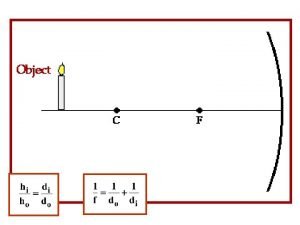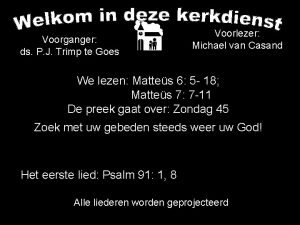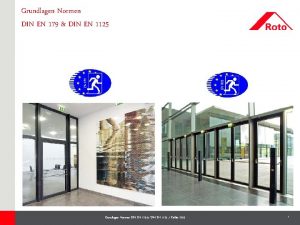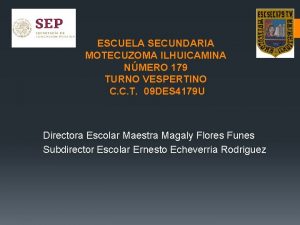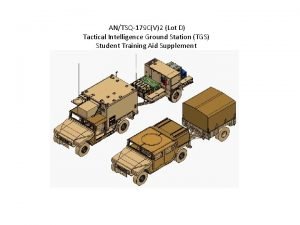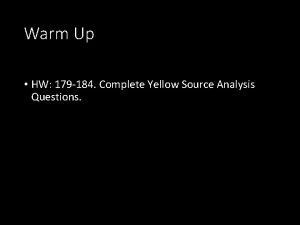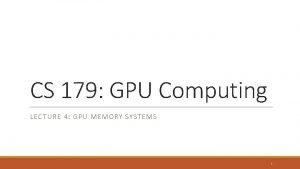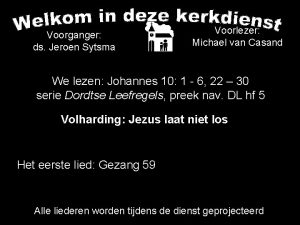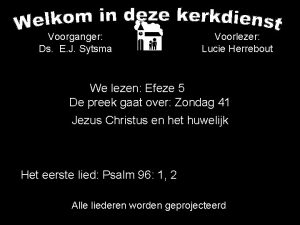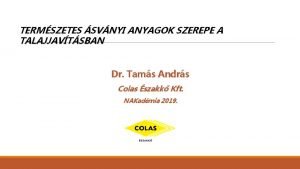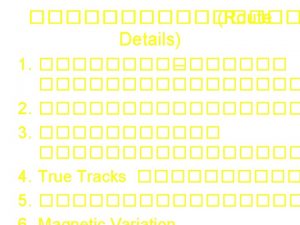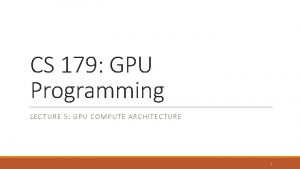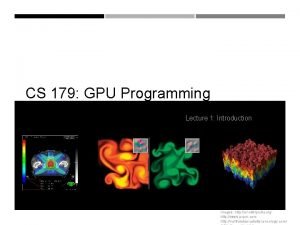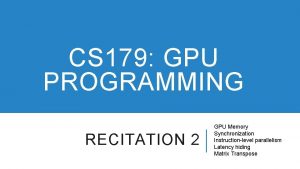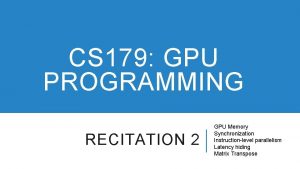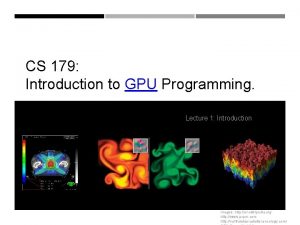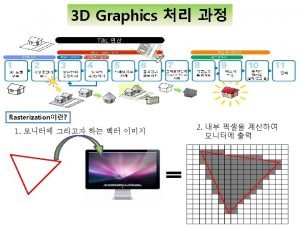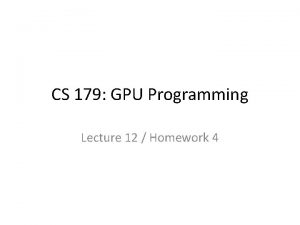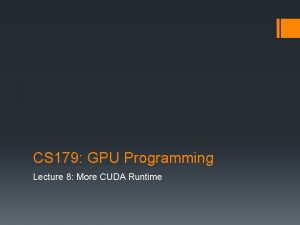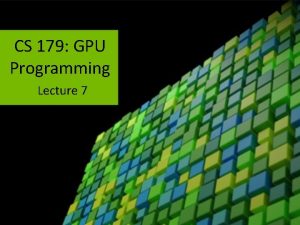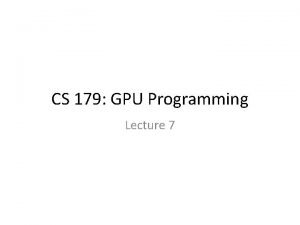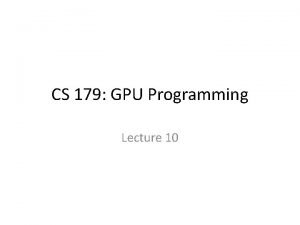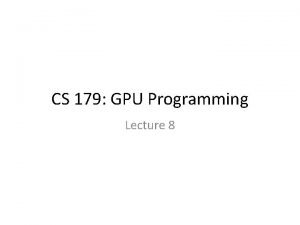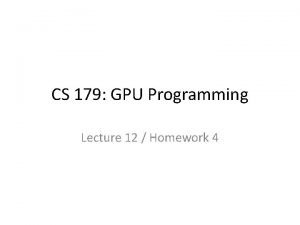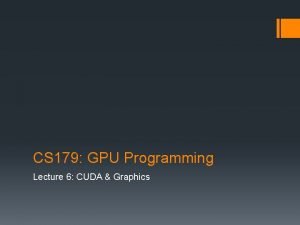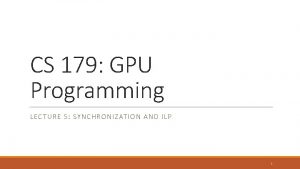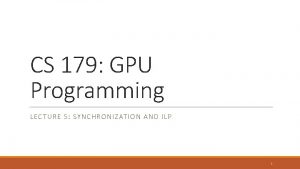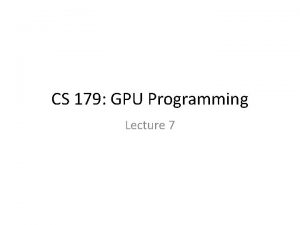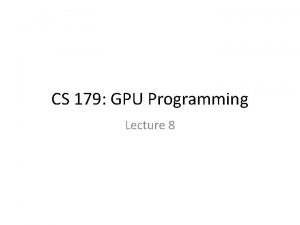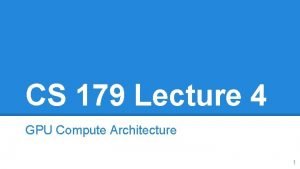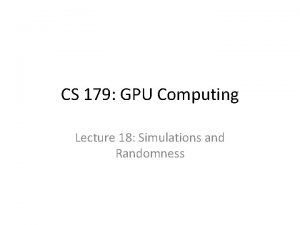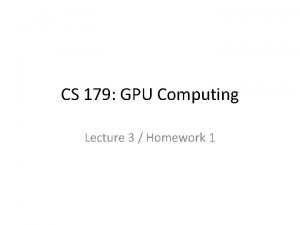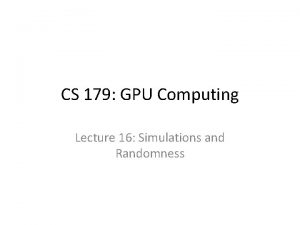CS 179 GPU Programming Lecture 1 Introduction Images












![EXAMPLE Add two arrays A[] + B[] -> C[] On the CPU: float *C EXAMPLE Add two arrays A[] + B[] -> C[] On the CPU: float *C](https://slidetodoc.com/presentation_image/0c089a29a9901e5d028a17f0b66cb17a/image-13.jpg)














- Slides: 27

CS 179: GPU Programming Lecture 1: Introduction Images: http: //en. wikipedia. org http: //www. pcper. com http: //northdallasradiationoncology. com/

Administration Covered topics: (GP)GPU computing/parallelization C++ CUDA (parallel computing platform) TAs: Andrew Zhao (azhao@dmail. caltech. edu) Parker Won (jwon@caltech. edu) Nailen Matchstick (nailen@caltech. edu) Jordan Bonilla (jbonilla@caltech. edu) Website: http: //courses. cms. caltech. edu/cs 179/ Overseeing Instructor: Al Barr (barr@cs. caltech. edu) Class time: ANB 107, MWF 3: 00 PM

Course Requirements Homework: 6 weekly assignments Each worth 10% of grade Final project: 4 -week project 40% of grade total

Homework Due on Wednesdays before class (3 PM) Collaboration policy: Discuss ideas and strategies freely, but all code must be your own Office Hours: Located in ANB 104 Times: TBA (will be announced before first set is out) Extensions Ask a TA for one if you have a valid reason

Projects Topic of your choice We will also provide many options Teams of up to 2 people 2 -person teams will be held to higher expectations Requirements Project Proposal Progress report(s) and Final Presentation More info later…

Machines Primary machine (multi-GPU, remote access): haru. caltech. edu Secondary machines mx. cms. caltech. edu minuteman. cms. caltech. edu Use your CMS login NOTE: Not all assignments work on these machines Change your password Use passwd command

Machines Alternative: Use your own machine: Must have an NVIDIA CUDA-capable GPU Virtual machines won’t work Exception: Machines with I/O MMU virtualization and certain GPUs Special requirements for: Hybrid/optimus systems Mac/OS X Setup guides posted on the course website

Machines OS/Server Access Survey PLEASE take this survey by 12 PM Wednesday (03/30/2016) https: //www. surveymonkey. com/r/DTKX 2 HX (link will be sent out via email after class)

The CPU The “Central Processing Unit” Traditionally, applications use CPU for primary calculations General-purpose capabilities Established technology Usually equipped with 8 or less powerful cores Optimal for concurrent processes but not large scale parallel computations Wikimedia commons: Intel_CPU_Pentium_4_640_Prescott_bottom. jpg

The CPU The “Central Processing Unit” Traditionally, applications use CPU for primary calculations General-purpose capabilities Established technology Usually equipped with 8 or less powerful cores Optimal for concurrent processes but not large scale parallel computations Wikimedia commons: Intel_CPU_Pentium_4_640_Prescott_bottom. jpg

The GPU The "Graphics Processing Unit" Relatively new technology designed for parallelizable problems Initially created specifically for graphics Became more capable of general computations

GPUs – The Motivation Raytracing: for all pixels (i, j): Calculate ray point and direction in 3 d space if ray intersects object: Superquadric Cylinders, exponent 0. 1, yellow glass balls, Barr, calculate lighting at closest object 1981 store color of (i, j)
![EXAMPLE Add two arrays A B C On the CPU float C EXAMPLE Add two arrays A[] + B[] -> C[] On the CPU: float *C](https://slidetodoc.com/presentation_image/0c089a29a9901e5d028a17f0b66cb17a/image-13.jpg)
EXAMPLE Add two arrays A[] + B[] -> C[] On the CPU: float *C = malloc(N * sizeof(float)); for (int i = 0; i < N; i++) C[i] = A[i] + B[i]; Operates sequentially… can we do better?

A simple problem… On the CPU (multi-threaded, pseudocode): (allocate memory for C) Create # of threads equal to number of cores on processor (around 2, 4, perhaps 8) (Indicate portions of A, B, C to each thread. . . ). . . In each thread, For (i from beginning region of thread) C[i] <- A[i] + B[i] //lots of waiting involved for memory reads, writes, . . . Wait for threads to synchronize. . . Slightly faster – 2 -8 x (slightly more with other tricks)

A simple problem… How many threads? How does performance scale? Context switching: High penalty on the CPU Low penalty on the GPU

A simple problem… On the GPU: (allocate memory for A, B, C on GPU) Create the “kernel” – each thread will perform one (or a few) additions Specify the following kernel operation: For (all i‘s assigned to this thread) C[i] <- A[i] + B[i] Start ~20000 (!) threads Wait for threads to synchronize. . .

GPU: Strengths Revealed Parallelism / lots of cores Low context switch penalty! We can “cover up” performance loss by creating more threads!

GPU Computing: Step by Step Setup inputs on the host (CPU-accessible memory) Allocate memory for inputs on the GPU Allocate memory for outputs on the host Allocate memory for outputs on the GPU Copy inputs from host to GPU Start GPU kernel Copy output from GPU to host (Copying can be asynchronous)

The Kernel Our “parallel” function Simplementation

Indexing Can get a block ID and thread ID within the block: Unique thread ID!

Calling the Kernel

Calling the Kernel (2)

Questions?

GPUs – Brief History Fixed-function pipelines Pre-set functions, limited options http: //gamedevelopment. tutsplus. com/articles/the-end -of-fixed-function-rendering-pipelines-and-how-tomove-on--cms-21469 Source: Super Mario 64, by Nintendo

GPUs – Brief History Shaders Could implement one’s own functions! GLSL (C-like language) Could “sneak in” general-purpose programming! http: //minecraftsix. com/glsl-shaders-mod/

GPUs – Brief History CUDA (Compute Unified Device Architecture) General-purpose parallel computing platform for NVIDIA GPUs Open. CL (Open Computing Language) General heterogenous computing framework … Accessible as extensions to C! (and other languages…)

GPUs Today “General-purpose computing on GPUs” (GPGPU)
 01:640:244 lecture notes - lecture 15: plat, idah, farad
01:640:244 lecture notes - lecture 15: plat, idah, farad C data types with examples
C data types with examples Real image vs virtual image
Real image vs virtual image Real images vs virtual images
Real images vs virtual images Mail @ malaysia.images.search.yahoo.com
Mail @ malaysia.images.search.yahoo.com How to save images on google images
How to save images on google images Https://tw.images.search.yahoo.com/images/view
Https://tw.images.search.yahoo.com/images/view Perbedaan linear programming dan integer programming
Perbedaan linear programming dan integer programming Greedy algorithm vs dynamic programming
Greedy algorithm vs dynamic programming Components of system programming
Components of system programming Linear vs integer programming
Linear vs integer programming Perbedaan linear programming dan integer programming
Perbedaan linear programming dan integer programming Gezang 179
Gezang 179 Cara memanfaatkan hati
Cara memanfaatkan hati Gezang 179
Gezang 179 Jhs 179
Jhs 179 Himno 179
Himno 179 Paniktüren nach din en 1125
Paniktüren nach din en 1125 Motecuzoma
Motecuzoma Tactical intelligence ground station
Tactical intelligence ground station Hw-179
Hw-179 Gezang 179
Gezang 179 Cs 179
Cs 179 Gezang 179
Gezang 179 Gezang 179
Gezang 179 Signing naturally page 179 answers
Signing naturally page 179 answers 791-179-455
791-179-455 0-179 altitude
0-179 altitude



